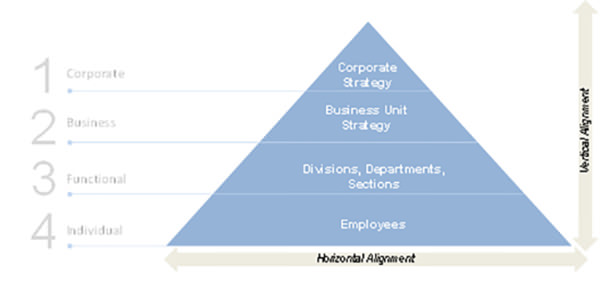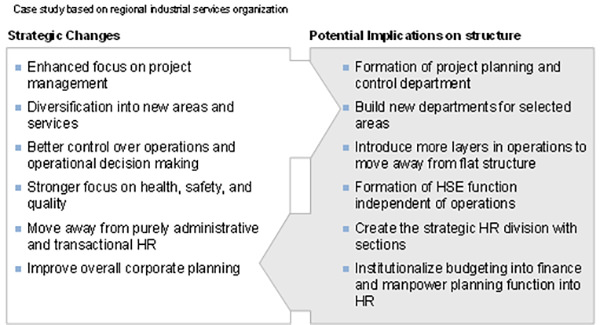Beyond Alignment: Why the Right Strategies Fail

It was the great Sir Winston Churchill, who once said, “however beautiful the strategy, you should occasionally look at the results.” Although these words were uttered close to a century ago, they were beyond their time and hinted to one of the most critical challenges executives face today-strategy execution. It is no secret that most strategies never reach full realization, with an estimated 70% failing to achieve their desired results. The reason for the failure is rarely due to the design of the strategy, or its beauty as Sir Winston would say, but mainly due to failures in implementation. From unclear visions and strategies, to lack of proper monitoring and control, to ineffective communication, the barriers to strategy execution are many. However, alignment or the ability of the organization to synchronize itself around the strategy remains one of the biggest and most complex hurdles to overcome.
Unfortunately, in the relatively young field of strategy execution the concept of alignment has not always been fully conceived. In many cases, alignment has been too narrowly defined to simply entail the cascading of the Balanced Scorecard across the organization, and ensuring its vertical and horizontal alignment. If you think you have achieved alignment in your organization simply by cascading a scorecard in your organization, then good luck executing your strategy!
Real alignment in an organization goes beyond cascading, and is much more encompassing. It strives to ensure that all parts of the organization are working in sync to achieve the strategy like the gears of time. In order to achieve full alignment in an organization, three principal levers must be realized (Exhibit 1).
Exhibit 1: The Three Levers of Alignment

Strategic Alignment
Vertical
Strategic alignment takes two forms (Exhibit 2), the first of which is vertical; ensuring that strategic objectives, targets, and initiatives of the corporate are aligned to all business units. When this is done properly in an organization, infuriated executives complaining that their “IT or HR department does not support the business needs,” becomes more of an anomaly than a norm. Like a series of steps, this cascading should take place all the way down to the individual level. Ultimately, the real strategy implementers or the de-facto strategists of an organization are the employees, and thus it is ever so critical that their objectives, targets, and initiatives also work towards achieving the corporate strategy.
When strategy is fully cascaded down in an organization, a vital linkage occurs where the performance management system starts talking to the strategy. The old management adage, of “you can manage (or execute) what you only measure,” comes into full play and the strategy begins to get measured and monitored, and thus is executed more effectively. Although there are many benefits of using the Balanced Scorecard approach, including its holistic and balanced perspectives, the real fundamental value it brings is creating that vital linkage between strategy and performance and hence this is why it’s such a pivotal tool for execution.
Horizontal
The second form is horizontal alignment, and when this is done properly common contention zones in organizations like between sales and operations departments become more harmonized. Hence, the likelihood of hearing operations people criticize the sales department’s ability to understand the capability and capacity of production, becomes minimized. This bolstering of coordination and alignment occurs as objectives, targets, and initiatives are clarified and agreed upon amongst the units.
In practice, however, horizontal alignment is often done poorly, and is an afterthought as it becomes a simple mechanical exercise of comparing strategy maps and objectives. However, when done properly, synergies, economies of scale, and duplications of work, amongst business units should be realized, leading to potentially immense cost savings and benefits.
Exhibit 2: Strategic Alignment

Operational Alignment
Processes
Many organizations these days are vaguely proclaiming to have strategies based on innovation or are attempting to be leaders in customer centricity. Other than firstly defining what this exactly means, these organizations need to ensure that they have the right processes in place to make this strategy happen. Google, which is often in the global top 5 of most innovative companies, has specific HR processes and policies such as 20% time which allocates approximately one day a week to innovative side projects. This has generated such impactful products as gmail, google news, and ad-sense. At a more local level, the Saudi heavyweight Al Marai, which is the largest vertically integrated dairy producer in the world, and is ranked in the global top 50 of innovative companies also has specific processes which enable a strategy focused on innovation. Al Marai employs a robust product development process and methodology dubbed Stage-Gate which drives product innovation from idea to launch. On the flipside, some organizations may be implementing processes which stifle the strategy. One project-based organization in the Middle East, which had specific strategic objectives related to speed and agility, was implementing an extremely bureaucratic procurement process. Synchronization of processes to the strategy of the organization, is a key piece to the execution puzzle, and needs to be assessed in every organization.
Operational Planning
Within every long-term strategic plan there is a short-term operational plan, which is usually done on a yearly basis, and breaks down the longer term objectives and initiatives into shorter term achievements, milestones, and targets. Elements such as manpower requirements should be outlined in this plan, ensuring the right resource leveling to enable the strategy. The operations planned for the year to come should be synchronized with the longer term strategy and operational reviews should be in place to monitor operational progress and alignment to the strategy.
Budgeting
Finally, at upmost importance to executing a strategy is ensuring the right funds are available and protected to implement the organization’s strategic initiatives. This often requires implementing a more strategic budgeting model where the strategic initiatives drive the corporate budget and not historical figures and forecasts. In this way, budget is not allotted based on managerial might or which department creates the most noise, but is seen through a pure strategic lens. In addition, in today’s dynamic business environment it is important to insert some flexibility into the budgeting process to enhance execution by adapting to shifts in business dynamics during the duration of the year.
Organizational Alignment
Leadership and Culture
The true lynchpin to strategy execution is in the hands of leadership and the culture it nurtures. Management guru Peter Drucker said it best, simply put “culture eats strategy for breakfast,” and after executing 100’s of projects in the Middle East region, we can attest to Mr. Drucker’s point of view. An interesting boardroom alignment exercise (which we routinely do) occurs when the executive team is individually asked to list their top three strategic priorities on a small sheet of white paper. After comparing answers, the results are usually surprising, and what is seen is various forms of misalignment amongst the leadership team. Clarity, unity, and clear decision rights amongst the captain and main crew of his/her ship is paramount; without it the ship often will go astray.
It is quite clear that the critical and collective behaviors of the organization, which represent the culture, is often the biggest impediment to executing a strategy successfully. 70% of strategic change programs fail, often due to cultural issues, and over 50% of business leaders claim that their current corporate cultures are in need of a major overhaul. However, what is not very clear in the management world, is how can we transform and change this culture. The secret lies in understanding that cultural change is not just a “soft” issue, but is also driven by many “hard” elements (e.g. rewards and incentives, organizational structure, processes, etc.). Nevertheless, principal to fostering the right culture is the leader’s role, and the best of the C suite understand that nurturing the right culture is their fundamental job; former Microsoft CEO Steve Ballmer delivers this message clearly-“everything I do is a reinforcement or not of what we want to have happen culturally.”
Structure
A journey through rugged desert lands is going to require a completely different vehicle than a high speed pursuit across a highway. In the same token, you have to choose the right vehicle (organizational structure) for the particular journey you are trying to pursue (strategy). When these two elements are misaligned it is tantamount to taking a Ferrari across rugged desert train, rendering disastrous consequences. An organization’s strategy which hinges on innovative and quick product launches will have a structure completely different from one which focuses on cost reduction and operational control.
Critical strategic decisions in an organization will require shifts in the organizational structure (Exhibit 3), and it is often said that looking at an organizational structure can sometimes give more information about an organization’s strategy than the strategy map itself.
Exhibit 3: Structural Alignment

Capabilities
Going hand in hand with the organizational structure, are the individuals who will fill in the boxes. Quite simply, an organization which wants to become more innovative, needs to recruit people with these competencies and train and develop those who are lacking in those skills. At the end of the day, no matter how aligned your budget, processes, structure, etc.; it is the people who will execute, thus much precedence should be applied to aligning the people competencies (especially for strategic positions) to the strategy of the organization.
Systems
IT-business alignment has always been a lingering issue in organization’s and over 50% of executives agree that it is still a major problem for them with many system implementations misaligned to the strategy. Southwest Airlines which puts technology at the forefront of its business model, and heavily stresses this form of alignment, designs its technological systems with its customer centric strategy in mind. In fact, at Southwest, IT employees are not hired based on their technical knowledge, but hired on their passion for customer service and open communication. At a more regional level, Al Marai, has implemented a variety of systems aligned to the strategy. They have introduced a product lifecycle management software which enables their innovation strategy by automating the ideation process, capturing a wider audience and consequent range of ideas, and prioritizing the innovative solutions recommended.
Technology implementations can also have the opposite effect on organizations, by sending the strategy into a disarray. A failed technology project almost brought down a fortune 500 powerhouse with Hershey foods, where an array of problems related to a botched ERP implementation, caused over $100 million of Hershey kisses to not be delivered during Halloween. Moreover, it was a direct cause of an 8% dip in company share price and definitely was not the sweetest experience for the global heavyweight (no pun intended).
Unlocking Alignment’s Potential
Like the hands of time, the organization and its strategy need to be synchronized to ensure that the right strategies don’t fail and bring their intended benefits to the organization. The core moving parts of the organization need to work towards achieving an organization’s strategy and ultimate vision. However, achieving full alignment can be a complex endeavor and is sometimes an elusive feat for organizations. However, achieving it requires taking a holistic view of alignment which goes far beyond cascading objectives and KPIs. This view should be seen across three critical alignment lenses; strategic, operational, and organizational.
- Strategic: Ensuring strategy and performance management are linked, and aligning the core units of the organization (corporate, business, functional, individual) to the strategy
- Operational: Linking strategy to operations and aligning resources, funds, and core activities
- Organizational: Aligning core fundamentals of the operating model (leadership, culture, structure, etc.) to realize the strategy
As organizations embark on their journeys to implement their strategies they should be paying attention to the three levers of alignment, and most importantly have a mind-set in which the design of any fundamental element in the organization is done with the strategy in mind.
*Sources: All information above is based on primary and secondary research conducted by Caliber Consulting

